外研版(2019)选择性必修 第三册Unit 6 Nature in words Developing ideas教案
文档属性
| 名称 | 外研版(2019)选择性必修 第三册Unit 6 Nature in words Developing ideas教案 | 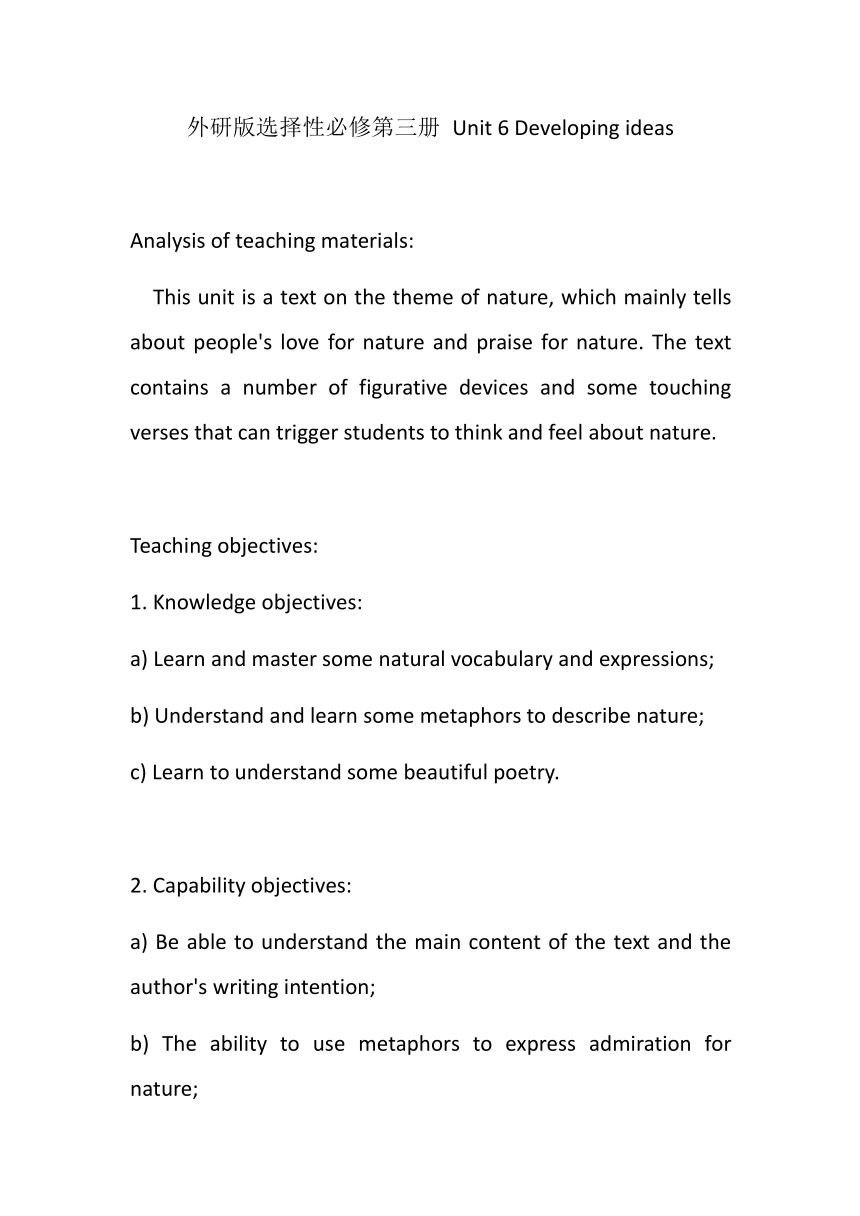 | |
| 格式 | docx | ||
| 文件大小 | 17.5KB | ||
| 资源类型 | 教案 | ||
| 版本资源 | 外研版(2019) | ||
| 科目 | 英语 | ||
| 更新时间 | 2024-03-18 12:13:32 | ||
图片预览

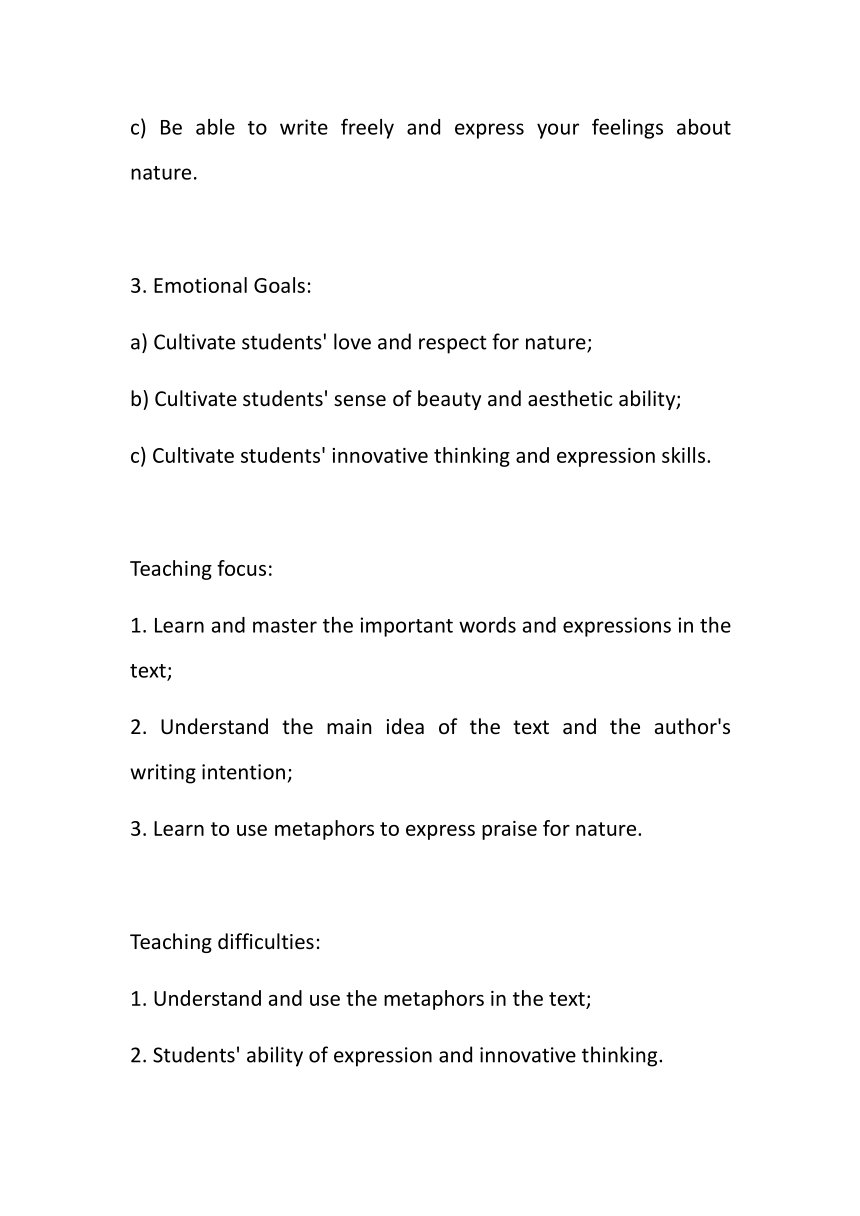
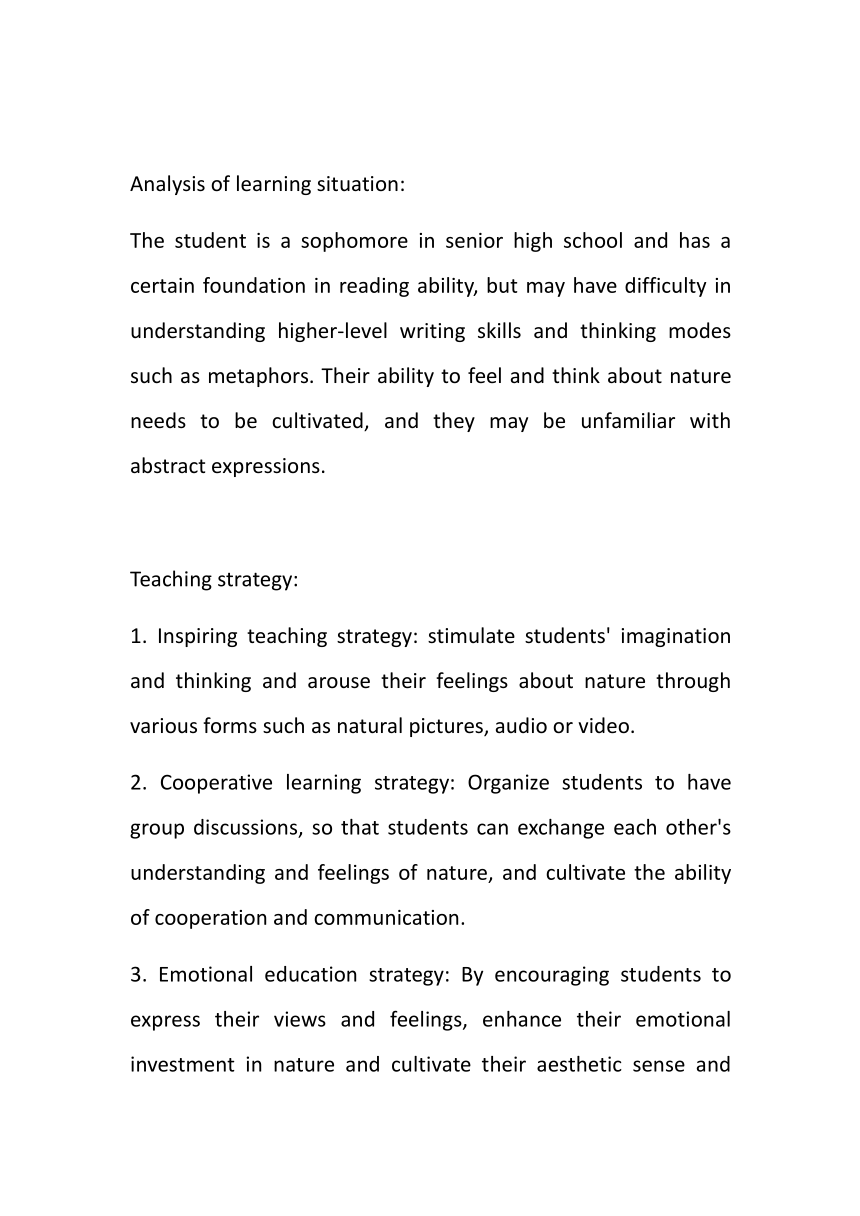
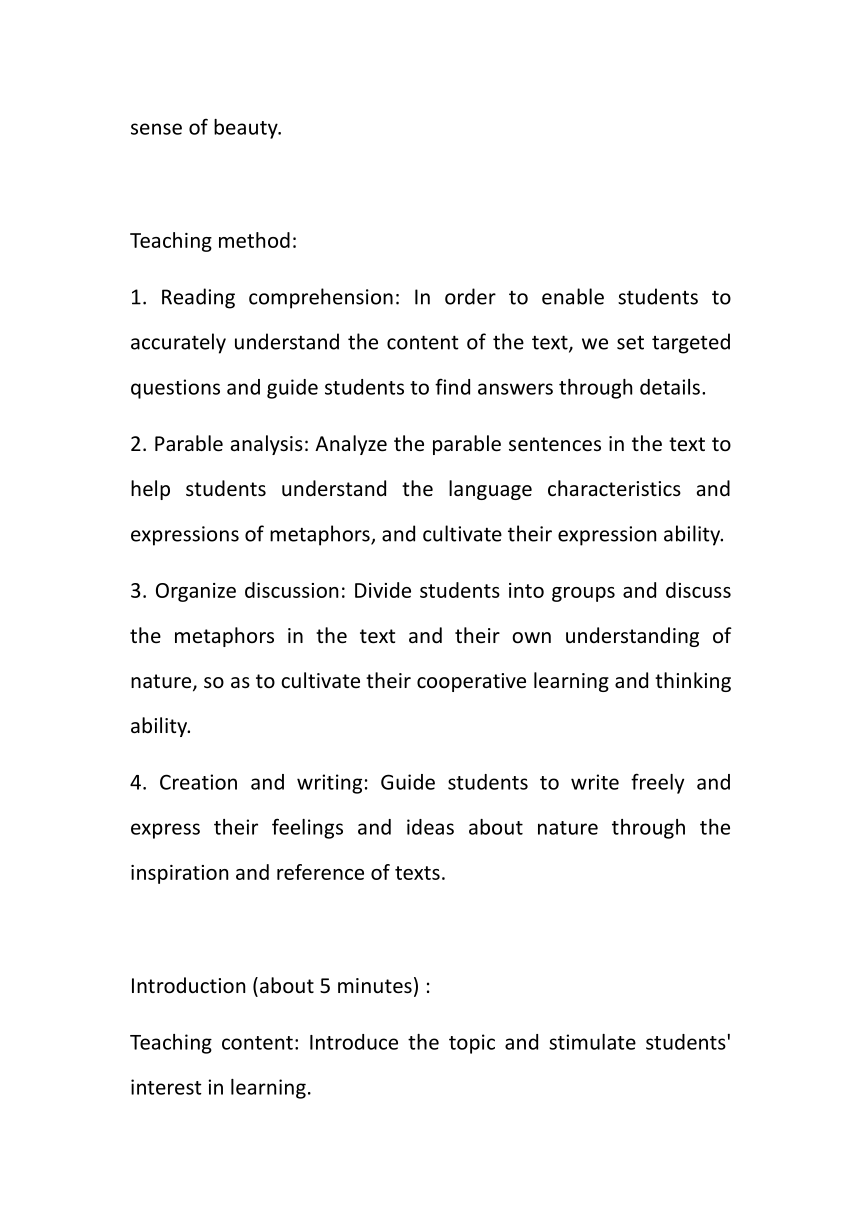
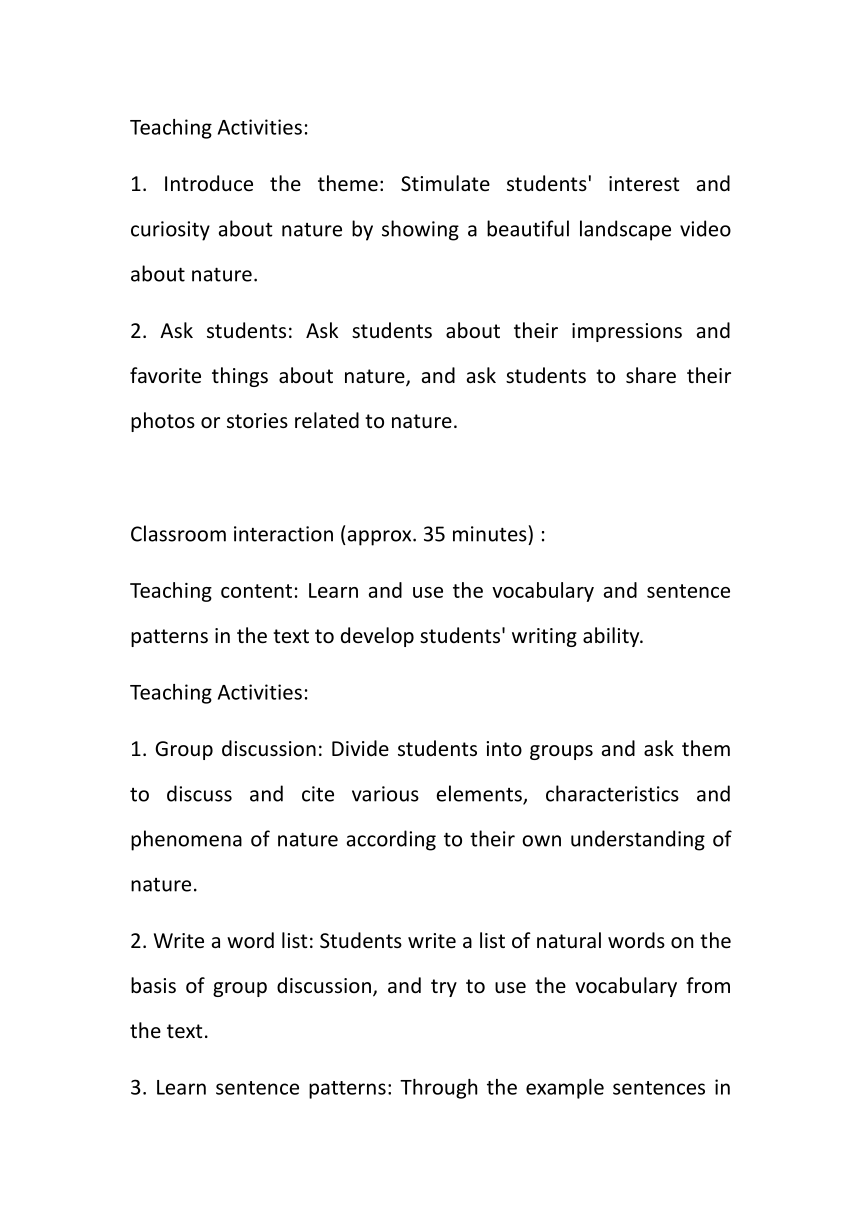
文档简介
外研版选择性必修第三册 Unit 6 Developing ideas
Analysis of teaching materials:
This unit is a text on the theme of nature, which mainly tells about people's love for nature and praise for nature. The text contains a number of figurative devices and some touching verses that can trigger students to think and feel about nature.
Teaching objectives:
1. Knowledge objectives:
a) Learn and master some natural vocabulary and expressions;
b) Understand and learn some metaphors to describe nature;
c) Learn to understand some beautiful poetry.
2. Capability objectives:
a) Be able to understand the main content of the text and the author's writing intention;
b) The ability to use metaphors to express admiration for nature;
c) Be able to write freely and express your feelings about nature.
3. Emotional Goals:
a) Cultivate students' love and respect for nature;
b) Cultivate students' sense of beauty and aesthetic ability;
c) Cultivate students' innovative thinking and expression skills.
Teaching focus:
1. Learn and master the important words and expressions in the text;
2. Understand the main idea of the text and the author's writing intention;
3. Learn to use metaphors to express praise for nature.
Teaching difficulties:
1. Understand and use the metaphors in the text;
2. Students' ability of expression and innovative thinking.
Analysis of learning situation:
The student is a sophomore in senior high school and has a certain foundation in reading ability, but may have difficulty in understanding higher-level writing skills and thinking modes such as metaphors. Their ability to feel and think about nature needs to be cultivated, and they may be unfamiliar with abstract expressions.
Teaching strategy:
1. Inspiring teaching strategy: stimulate students' imagination and thinking and arouse their feelings about nature through various forms such as natural pictures, audio or video.
2. Cooperative learning strategy: Organize students to have group discussions, so that students can exchange each other's understanding and feelings of nature, and cultivate the ability of cooperation and communication.
3. Emotional education strategy: By encouraging students to express their views and feelings, enhance their emotional investment in nature and cultivate their aesthetic sense and sense of beauty.
Teaching method:
1. Reading comprehension: In order to enable students to accurately understand the content of the text, we set targeted questions and guide students to find answers through details.
2. Parable analysis: Analyze the parable sentences in the text to help students understand the language characteristics and expressions of metaphors, and cultivate their expression ability.
3. Organize discussion: Divide students into groups and discuss the metaphors in the text and their own understanding of nature, so as to cultivate their cooperative learning and thinking ability.
4. Creation and writing: Guide students to write freely and express their feelings and ideas about nature through the inspiration and reference of texts.
Introduction (about 5 minutes) :
Teaching content: Introduce the topic and stimulate students' interest in learning.
Teaching Activities:
1. Introduce the theme: Stimulate students' interest and curiosity about nature by showing a beautiful landscape video about nature.
2. Ask students: Ask students about their impressions and favorite things about nature, and ask students to share their photos or stories related to nature.
Classroom interaction (approx. 35 minutes) :
Teaching content: Learn and use the vocabulary and sentence patterns in the text to develop students' writing ability.
Teaching Activities:
1. Group discussion: Divide students into groups and ask them to discuss and cite various elements, characteristics and phenomena of nature according to their own understanding of nature.
2. Write a word list: Students write a list of natural words on the basis of group discussion, and try to use the vocabulary from the text.
3. Learn sentence patterns: Through the example sentences in the text, let students learn and master the sentence structures describing nature, such as "Nothing beats + n. + for + adj.".
4. Write a paragraph: Students write a description of nature using their own word list and the sentence patterns they have learned.
End session (approx. 5 minutes) :
Teaching content: Give feedback to students and summarize the teaching content.
Teaching Activities:
1. Randomly show students' passages: Ask several students to randomly show their own passages about nature and make class comments.
2. Summary and reminder: Summarize the vocabulary and sentence patterns about nature that students have learned in this lesson and remind them to pay attention to the use of these knowledge in writing.
Stimulate students' interest through introduction, guide students to learn and use vocabulary and sentence patterns in classroom interaction, and summarize and remind students' learning in the end. Through this teaching process, students can be helped to better understand and use English to express natural ability.
Class exercises:
1. Choose the right words to fill in the blanks according to the text.
The beauty of __________ is beyond words.
A. environment B. nature C. pollution D. civilization
Answer: B. nature. B. The beauty of nature is beyond words. B. The beauty of nature is beyond words.
2. According to the text, choose the best answer to complete the sentence.
_________ words, the author describes the vividness and beauty of nature.
A. In B. Under C. Through D. Beyond
Answer: C. Through. Through words, the author describes the vividness and beauty of nature. C. through
3. Please answer the questions according to the text.
Why did the author mention the snow-capped peaks and the waves breaking on the shore
________________________________________________________________
Answer and Explanation: The author mentioned the snow-capped peaks and the waves breaking on the shore to give vivid and specific examples of the beauty of nature.
Teaching reflection:
in this lesson, I chose the teaching topic of Unit 6 Nature in Words Developing ideas in Volume 3 of the optional compulsory course. Classroom exercises are designed to help students consolidate and use key words, phrases and sentence patterns in the text, and to test their understanding of the content and ideas in the text. According to the actual performance and feedback of the students, most of the students can complete the exercises correctly, and the understanding of the text is relatively in place.
However, through the observation of the teaching process, I found that there were still some students who had difficulties in understanding the abstract concepts in the text and in using vocabulary and phrases. This may be because I did not give enough explanation and guidance for these difficulties in the teaching process. Therefore, I believe that in the future teaching, we should strengthen the explanation of abstract concepts and case analysis, and design more targeted classroom exercises and activities to help students consolidate and apply what they have learned.
In addition, in the teaching reflection, I also realized that better use of multiple teaching methods and resources in this class can improve the teaching effect. Multimedia resources such as pictures, video and audio can be used to enhance students' perception and understanding of the beauty of nature. At the same time, I should also pay more attention to students' cooperative learning and interactive discussion, encourage them to actively participate in class activities, and enhance students' learning interest and initiative.
To sum up, this teaching experience tells me that in teaching, we should pay attention to the actual situation and learning difficulties of students, design exercises and teaching activities reasonably, use diversified teaching resources and methods, and improve the learning effect and interest of students. Through in-depth analysis of the problem and putting forward improvement plans, I believe I can do better in the future teaching.
Analysis of teaching materials:
This unit is a text on the theme of nature, which mainly tells about people's love for nature and praise for nature. The text contains a number of figurative devices and some touching verses that can trigger students to think and feel about nature.
Teaching objectives:
1. Knowledge objectives:
a) Learn and master some natural vocabulary and expressions;
b) Understand and learn some metaphors to describe nature;
c) Learn to understand some beautiful poetry.
2. Capability objectives:
a) Be able to understand the main content of the text and the author's writing intention;
b) The ability to use metaphors to express admiration for nature;
c) Be able to write freely and express your feelings about nature.
3. Emotional Goals:
a) Cultivate students' love and respect for nature;
b) Cultivate students' sense of beauty and aesthetic ability;
c) Cultivate students' innovative thinking and expression skills.
Teaching focus:
1. Learn and master the important words and expressions in the text;
2. Understand the main idea of the text and the author's writing intention;
3. Learn to use metaphors to express praise for nature.
Teaching difficulties:
1. Understand and use the metaphors in the text;
2. Students' ability of expression and innovative thinking.
Analysis of learning situation:
The student is a sophomore in senior high school and has a certain foundation in reading ability, but may have difficulty in understanding higher-level writing skills and thinking modes such as metaphors. Their ability to feel and think about nature needs to be cultivated, and they may be unfamiliar with abstract expressions.
Teaching strategy:
1. Inspiring teaching strategy: stimulate students' imagination and thinking and arouse their feelings about nature through various forms such as natural pictures, audio or video.
2. Cooperative learning strategy: Organize students to have group discussions, so that students can exchange each other's understanding and feelings of nature, and cultivate the ability of cooperation and communication.
3. Emotional education strategy: By encouraging students to express their views and feelings, enhance their emotional investment in nature and cultivate their aesthetic sense and sense of beauty.
Teaching method:
1. Reading comprehension: In order to enable students to accurately understand the content of the text, we set targeted questions and guide students to find answers through details.
2. Parable analysis: Analyze the parable sentences in the text to help students understand the language characteristics and expressions of metaphors, and cultivate their expression ability.
3. Organize discussion: Divide students into groups and discuss the metaphors in the text and their own understanding of nature, so as to cultivate their cooperative learning and thinking ability.
4. Creation and writing: Guide students to write freely and express their feelings and ideas about nature through the inspiration and reference of texts.
Introduction (about 5 minutes) :
Teaching content: Introduce the topic and stimulate students' interest in learning.
Teaching Activities:
1. Introduce the theme: Stimulate students' interest and curiosity about nature by showing a beautiful landscape video about nature.
2. Ask students: Ask students about their impressions and favorite things about nature, and ask students to share their photos or stories related to nature.
Classroom interaction (approx. 35 minutes) :
Teaching content: Learn and use the vocabulary and sentence patterns in the text to develop students' writing ability.
Teaching Activities:
1. Group discussion: Divide students into groups and ask them to discuss and cite various elements, characteristics and phenomena of nature according to their own understanding of nature.
2. Write a word list: Students write a list of natural words on the basis of group discussion, and try to use the vocabulary from the text.
3. Learn sentence patterns: Through the example sentences in the text, let students learn and master the sentence structures describing nature, such as "Nothing beats + n. + for + adj.".
4. Write a paragraph: Students write a description of nature using their own word list and the sentence patterns they have learned.
End session (approx. 5 minutes) :
Teaching content: Give feedback to students and summarize the teaching content.
Teaching Activities:
1. Randomly show students' passages: Ask several students to randomly show their own passages about nature and make class comments.
2. Summary and reminder: Summarize the vocabulary and sentence patterns about nature that students have learned in this lesson and remind them to pay attention to the use of these knowledge in writing.
Stimulate students' interest through introduction, guide students to learn and use vocabulary and sentence patterns in classroom interaction, and summarize and remind students' learning in the end. Through this teaching process, students can be helped to better understand and use English to express natural ability.
Class exercises:
1. Choose the right words to fill in the blanks according to the text.
The beauty of __________ is beyond words.
A. environment B. nature C. pollution D. civilization
Answer: B. nature. B. The beauty of nature is beyond words. B. The beauty of nature is beyond words.
2. According to the text, choose the best answer to complete the sentence.
_________ words, the author describes the vividness and beauty of nature.
A. In B. Under C. Through D. Beyond
Answer: C. Through. Through words, the author describes the vividness and beauty of nature. C. through
3. Please answer the questions according to the text.
Why did the author mention the snow-capped peaks and the waves breaking on the shore
________________________________________________________________
Answer and Explanation: The author mentioned the snow-capped peaks and the waves breaking on the shore to give vivid and specific examples of the beauty of nature.
Teaching reflection:
in this lesson, I chose the teaching topic of Unit 6 Nature in Words Developing ideas in Volume 3 of the optional compulsory course. Classroom exercises are designed to help students consolidate and use key words, phrases and sentence patterns in the text, and to test their understanding of the content and ideas in the text. According to the actual performance and feedback of the students, most of the students can complete the exercises correctly, and the understanding of the text is relatively in place.
However, through the observation of the teaching process, I found that there were still some students who had difficulties in understanding the abstract concepts in the text and in using vocabulary and phrases. This may be because I did not give enough explanation and guidance for these difficulties in the teaching process. Therefore, I believe that in the future teaching, we should strengthen the explanation of abstract concepts and case analysis, and design more targeted classroom exercises and activities to help students consolidate and apply what they have learned.
In addition, in the teaching reflection, I also realized that better use of multiple teaching methods and resources in this class can improve the teaching effect. Multimedia resources such as pictures, video and audio can be used to enhance students' perception and understanding of the beauty of nature. At the same time, I should also pay more attention to students' cooperative learning and interactive discussion, encourage them to actively participate in class activities, and enhance students' learning interest and initiative.
To sum up, this teaching experience tells me that in teaching, we should pay attention to the actual situation and learning difficulties of students, design exercises and teaching activities reasonably, use diversified teaching resources and methods, and improve the learning effect and interest of students. Through in-depth analysis of the problem and putting forward improvement plans, I believe I can do better in the future teaching.
